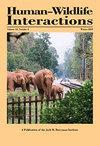Collective effect of landfills and landscape composition on bird–aircraft collisions
IF 0.9
4区 环境科学与生态学
Q4 BIODIVERSITY CONSERVATION
引用次数: 11
Abstract
Ninety-three percent of all reported bird strikes occur below 1,067 m, which based on the typical approach and departure angles of aircraft is within 8–13 km of an airport. Concomitantly, the Federal Aviation Administration and the International Civil Aviation Organization recommend that any feature that would attract hazardous wildlife to the approach and departure airspace be restricted. Thus, preventing the establishment of wildlife attractants, such as municipal solid waste landfills (MSWLFs) within 8 km or 13 km extents (U.S. and international recommendations, respectively) of airports, has been recommended to mitigate the risk of bird–aircraft collisions (strikes). However, robust evidence linking wildlife attractants at these spatial scales to an increase in strikes is lacking. We investigated the effect of densities of MSWLFs and construction and demolition (C&D) landfills, landscape diversity, and human population density on the adverse effect (AE; strikes that caused damage or had a negative effect on flight) bird strike rate involving species broadly associated with MSWLFs. We predicted that airports surrounded by a high density of MSWLFs, high human population densities, and high landscape diversity would increase the AE strike rate. We evaluated our predictions via generalized linear mixed models with bird strike data from 2009 through 2017 at 111 Part 139 airports. Only U.S. airports were used because of high wildlife strike reporting rates. Part 139 certificated airports are those that facilitate air carriers with >30 seats for passengers and crew. Our average model included density of MSWLFs and C&D landfills for both the 8and 13-km extent from the airports. We found no significant contribution by any variable to the AE strike rate variance. Our results indicated that the effects of landfills on AE strike rates are inconclusive. Possible explanations for our findings include the influence of unmeasured landscape features and lack of fine-scale data on bird habitat use at landfill facilities. Future research should investigate bird 3-dimensional space use in addition to bird and habitat survey techniques.堆填区和景观构成对鸟-机碰撞的集体效应
在所有报告的鸟击事件中,93%发生在1067米以下,根据飞机的典型进近和起飞角度,这是在机场8-13公里范围内。与此同时,美国联邦航空管理局(Federal Aviation Administration)和国际民用航空组织(International Civil Aviation Organization)建议,限制任何可能吸引危险野生动物进入进场和离场空域的设施。因此,建议防止在机场8公里或13公里范围内建立野生动物引诱剂,如城市固体废物填埋场(MSWLFs)(分别为美国和国际建议),以减轻鸟与飞机碰撞(撞击)的风险。然而,缺乏将这些空间尺度上的野生动物引诱剂与袭击事件增加联系起来的有力证据。我们调查了垃圾填埋场和建拆填埋场的密度、景观多样性和人口密度对负面影响的影响(AE;造成损害或对飞行产生负面影响的鸟击率,涉及与海洋自然保护区广泛相关的物种。结果表明,机场周边高密度的无水垃圾填埋场、高人口密度和高景观多样性将增加声发射命中率。我们通过广义线性混合模型和2009年至2017年在111个139部分机场的鸟击数据来评估我们的预测。由于野生动物袭击报告率高,只有美国机场被使用。第139部分认证的机场是那些为航空承运人提供乘客和机组人员超过30个座位的机场。我们的平均模型包括了距离机场8公里和13公里范围内的垃圾填埋场和堆填区的密度。我们没有发现任何变量对AE击中率方差的显著贡献。我们的结果表明,垃圾填埋场对声发射命中率的影响是不确定的。对我们的研究结果可能的解释包括未测量的景观特征的影响以及缺乏填埋场设施鸟类栖息地使用的精细数据。未来的研究应在鸟类和栖息地调查技术的基础上,进一步研究鸟类的三维空间利用。
本文章由计算机程序翻译,如有差异,请以英文原文为准。
求助全文
约1分钟内获得全文
求助全文
来源期刊

Human–Wildlife Interactions
Environmental Science-Nature and Landscape Conservation
CiteScore
2.80
自引率
0.00%
发文量
0
审稿时长
11 weeks
期刊介绍:
Human–Wildlife Interactions (HWI) serves the professional needs of the wildlife biologist and manager in the arena of human–wildlife conflicts/interactions, wildlife damage management, and contemporary wildlife management. The intent of HWI is to publish original contributions on all aspects of contemporary wildlife management and human–wildlife interactions with an emphasis on scientific research and management case studies that identify and report innovative conservation strategies, technologies, tools, and partnerships that can enhance human–wildlife interactions by mitigating human–wildlife conflicts through direct and indirect management of wildlife and increased stakeholder engagement. Our intent is to promote a dialogue among wildlife professionals concerning contemporary management issues. As such, we hope to provide a repository for wildlife management science and case studies that document and share manager experiences and lessons learned.
 求助内容:
求助内容: 应助结果提醒方式:
应助结果提醒方式:


